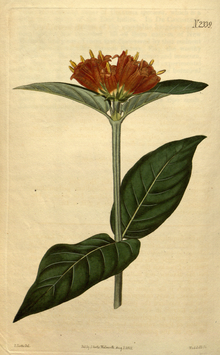Burchellia bubalina
| Burchellia bubalina | ||||||||||||
|---|---|---|---|---|---|---|---|---|---|---|---|---|

Burchellia bubalina |
||||||||||||
| Systematics | ||||||||||||
|
||||||||||||
| Scientific name of the genus | ||||||||||||
| Burchellia | ||||||||||||
| R.Br. | ||||||||||||
| Scientific name of the species | ||||||||||||
| Burchellia bubalina | ||||||||||||
| ( Lf ) Sims |
Burchellia is the only way the plant genus Burchellia within the family of the redness plants (Rubiaceae). It is a floral element of the Capensis . It is used as an ornamental plant. Trivial names are wild pomegranate in Englishand wildegranaat in Afrikaans , and so it is sometimescalled African pomegranate in German-speaking countries .
description
Appearance and leaf
Burchellia bubalina grows as an evergreen shrub or small tree that can reach heights of up to 8 meters. The smooth, gray-brown bark becomes rougher on older specimens. The bark of the branches is always hairy at first.
The constantly against arranged on the branches leaves are divided into petiole and leaf blade. The petiole is hairy. The simple leaf blade, which is initially soft and later becomes relatively thick and leathery, is egg-shaped with a length of 5 to 18 cm and a width of 2.5 to 8.0 cm. The top of the leaf is glossy dark green and the underside of the leaf is lighter with fine, soft hairs along the veins .
Inflorescence, flower and fruit
The flowering time in South Africa is between early spring and mid-summer. The flowers are in terminal, dense, bundled inflorescences .
The hermaphrodite flowers are five-fold with a double flower envelope . The five sepals are durable. The five bright red to orange petals are fused tubular. The sweet nectar attracts birds.
The urn-shaped fruits are initially green and turn brown and woody when ripe; they are crowned by durable, horn-like calyx lobes. The fruits stay on the tree for many months.
Chromosome number
The number of chromosomes is 2n = about 66.
Occurrence
Burchellia bubalina is a floral element of the Capensis . It occurs in Lesotho and Swaziland and in the South African provinces of Eastern Cape , KwaZulu-Natal , Limpopo , Mpumalanga and Western Cape . There it can be found in a strip along the coast.
It naturally thrives in forests and forest edges, rock outcrops and in bushes in mountainous grasslands .
Systematics
Burchellia is the only species of the genus Burchellia that the subfamily Ixoroideae within the family Rubiaceae belongs.
This species was in 1782 under the name Lonicera bubalina by Carl Linnaeus the Younger in Supplementum plantarum Systematis vegetabilium editionis decimae tertiae, Generum plantarum editionis sextae, et specierum plantarum editionis Secunda , p 146 first published . It was published in Botanical Magazine by John Sims in 1822 ; or, Flower-Garden Displayed ... London , 49, Plate 2339 placed in the genus Burchellia . The genus Burchellia was added to the Botanical Register by Robert Brown in 1820 ; Consisting of Colored Figures of Exotic Plants Cultivated in British Gardens; with their History and Mode of Treatment. London , 6, plate 466 put up. The generic name Burchellia honors the British naturalist and botanist William John Burchell (1781 - 1863), who carried out an expedition in South Africa. The epithet bubalina is derived from Latin; it is related to two species characteristics: the buff- colored trichomes of some forms and the buffalo-horn-like, durable calyxes on the fruits. A synonym for Burchellia R.Br. is Bubalina Raf. Other synonyms for Burchellia bubalina (L. f.) Sims are: Burchellia capensis R.Br. , Burchellia capensis var. Parviflora (Lindl.) Sond. , Burchellia kraussii Hochst. , Burchellia major Heynh. , Burchellia parviflora Lindl. , Burchellia speciosa Heynh. , Canephora capitata Willd. , Cephaelis bubalina (L. f.) Pers. , Genipa capensis (R.Br.) Baill.
use
Burchellia bubalina is used as an ornamental wood in partially shaded to sunny locations in parks and gardens. The decorative effect comes from the pomegranate- like flowers, hence the common names. The bark and roots are used medicinally. The hard wood is used to build huts and make agricultural implements.
swell
- Braam Van Wyk & Piet Van Wyk: Field Guide to Trees of Southern Africa (Field Guides) , Struik Publishers, 1997. ISBN 978-1868259229 : Burchellia bubalina on p. 278 (section description, use and occurrence)
- Mhlonishwa David Dlamini, 2005: Burchellia bubalina (L. f.) Sims in PlantzAfrica from the South African National Biodiversity Institute . (Section Description, Usage and Occurrence)
Individual evidence
- ↑ Burchellia bubalina at Tropicos.org. In: IPCN Chromosome Reports . Missouri Botanical Garden, St. Louis
- ^ A b Burchellia in the Germplasm Resources Information Network (GRIN), USDA , ARS , National Genetic Resources Program. National Germplasm Resources Laboratory, Beltsville, Maryland.
- ↑ Lotte Burkhardt: Directory of eponymous plant names . Extended Edition. Botanic Garden and Botanical Museum Berlin, Free University Berlin Berlin 2018. [1]
